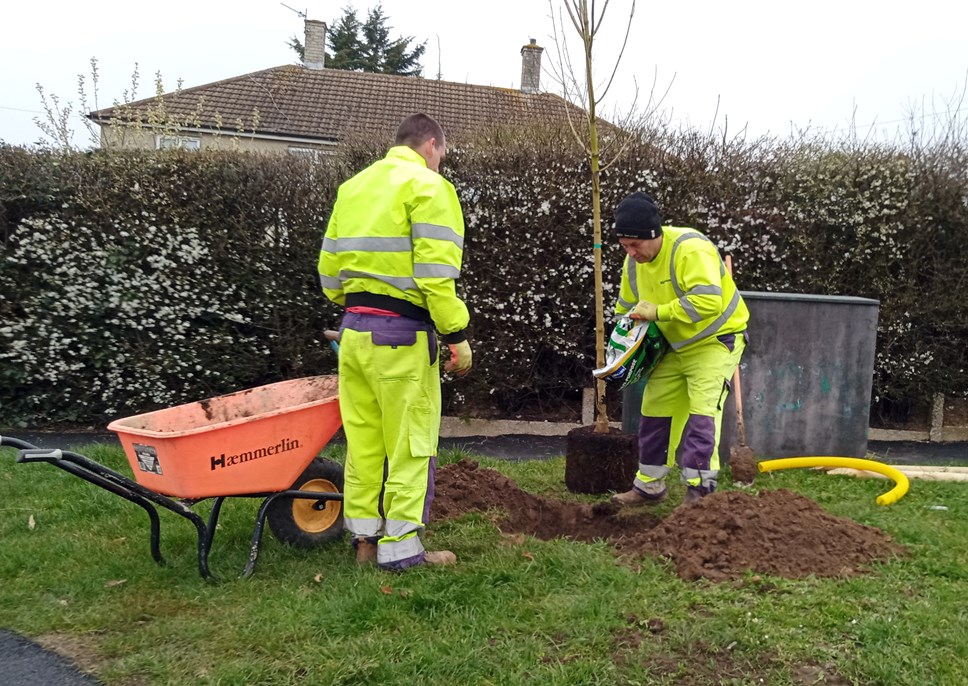
Reading’s Tree and Biodiversity Strategies Finalised
- ambitious aim for 3,000 new trees on Council land by 2030
- action plan sets out how we will conserve, enhance and reverse the decline of biodiversity in Reading
TWO key elements of Reading’s response to the climate emergency have been put in place today, with the publication of the final versions of the new Tree Strategy and Biodiversity Action Plan (Wednesday 3rd March). Both documents will help to deliver some of the actions from Reading’s new Climate Emergency Strategy.
The new Tree Strategy replaces the previous version, which dates from 2010. More than 2,000 trees have been planted since the previous strategy was put in place, but the new strategy is significantly more ambitious, aiming for 3,000 new trees on Council land by 2030, as well as increasing the proportion of land in Reading which is covered by tree canopy to 25% over the same timescale.
The Strategy also details how the Council will manage and maintain its own trees, as well as undertaking its duties in terms of protection of trees and ensuring new trees are planted as part of developments in the town. In addition, the Strategy sets out plans to engage with partners, the public and other landowners in the borough to raise awareness of the new strategy and the part they can play in achieving its ambitious goals.
The new Biodiversity Action Plan (BAP) is a much-needed replacement for the Council’s outdated 2006 Biodiversity Action Plan. Its purpose is to provide a high-level set of objectives and actions for how biodiversity, meaning the variety of plant and animal life, will be reflected in the full range of what the Council does. Biodiversity is reducing across the world, and, to tackle this, it is vital that impacts on biodiversity are a key part of how we make decisions.
The BAP identifies a number of vital themes, such as around types of habitat including woodlands, trees and hedges, grassland and road verges, and rivers, as well as around topics such as planning, education, sites of designated importance and sale of land. Each of these themes has a set of objectives and priority actions for the protection and enhancement of biodiversity within Reading.
Both the BAP and the Tree Strategy were subject to public consultation between May and July 2020, and the comments received have been invaluable in amending and finalising the documents. Both are documents that the Council intends to review and update on a regular basis, in order to adapt to the changing challenges that Reading faces in addressing the climate emergency.
Councillor Karen Rowland, Reading Borough Council’s Lead Member for Heritage, Culture and Recreation, said: “I am absolutely delighted we have formally published both of these important strategies and I would like to thank everyone who provided invaluable feedback via our public consultation last year.
“The targets for tree planting and canopy cover in Reading are intentionally ambitious and reflect the scale of the emergency that the world is facing. Trees play a crucial role in combatting the effects of climate change, and not only in terms of carbon reduction. Increasing tree cover helps with air quality, flood risk management, cooling and shading and encouraging wildlife, not to mention the fact that they make any town environment look like a more welcoming place.
“We all know that increasing tree cover is extremely challenging in a tight-knit urban landscape like Reading – far more so than in a more rural setting. The proposed planting of 3,000 new trees on Council land by 2030 represents a 50% increase over recent rates of planting. I’m heartened that this season we achieved the planting of 350 new trees across the borough, which exceeds the 330 trees planted during the Queen’s Jubilee year of 2012. To put into context, on average, we have planted around 200 semi-mature new trees a year, since 2010.
“However, the Council’s pledge will only be a part of the picture. Meeting these ambitious canopy cover targets will only be achieved when all landowners across Reading do their bit to plant and maintain new trees on their own properties. This is not something the Council can achieve on its own. I would like to urge local landowners to contact us if they would like to work in partnership with us to achieve this goal by planting on private land.”
Cllr Tony Page, Reading’s Lead Councillor for Strategic Environment, Planning and Transport, said: “Although a largely urban environment, Reading is incredibly rich in biodiversity along its rivers, in its parks, gardens and open spaces.
“Reading’s Biodiversity Action Plan action plan sets out how we will conserve, enhance and reverse the decline of biodiversity in Reading, which is a vital part of our response to the climate emergency.
“We want to restore, extend and create new wildlife sites and habitats. The BAP sets out ambitious and innovative approaches, many of which we have already started to successfully implement, such as trialling cutting large road verges with rich wildflower populations less frequently and identifying areas within parks that could be managed as longer grassland with wildflowers for pollinators.
“This will be an important legacy for future generations and I urge everyone to read the action plan and to support our continued efforts to reverse the decline of biodiversity in Reading.”
The documents can be viewed on the Council’s website at:
- Tree Strategy www.reading.gov.uk/planning/trees
- Biodiversity Action Plan https://www.reading.gov.uk/planning/reading-biodiversity-action-plan/
Anyone who would like further information on the strategies can contact: planning.naturalenvironment@reading.gov.uk
Ends


